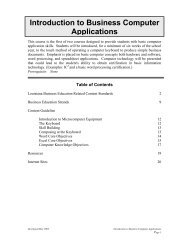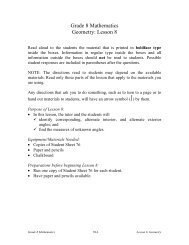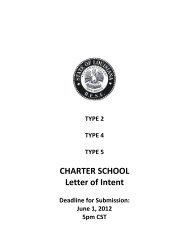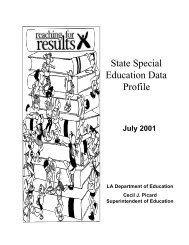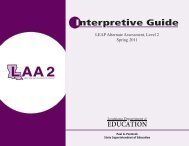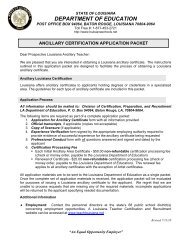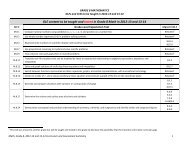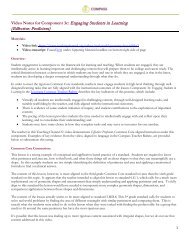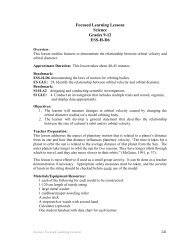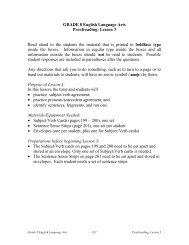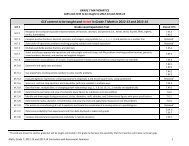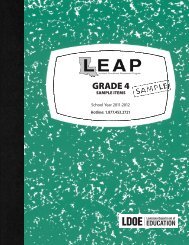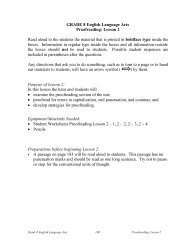School Improvement - Louisiana Department of Education
School Improvement - Louisiana Department of Education
School Improvement - Louisiana Department of Education
You also want an ePaper? Increase the reach of your titles
YUMPU automatically turns print PDFs into web optimized ePapers that Google loves.
<strong>Louisiana</strong> <strong>Department</strong> <strong>of</strong> <strong>Education</strong> Initiatives<br />
Best Practices included in <strong>School</strong> <strong>Improvement</strong> Plan<br />
1. Response to Intervention (RtI)<br />
2. Data‐Driven, Decision‐Making<br />
3. Job‐Embedded Pr<strong>of</strong>essional Development<br />
4. Curriculum Alignment<br />
5. Meaningful, Engaged Learning<br />
A brief description <strong>of</strong> each <strong>of</strong> the best practices is listed below.<br />
1. Response to Intervention (RtI)<br />
Response to Intervention (RtI) is a general education process that provides students with high‐quality research<br />
based instruction and interventions that are matched to the student’s specific needs. Data is used to drive<br />
decisions about student progress and to determine the appropriate instructional plan necessary for a student to<br />
achieve grade‐level success. Daily instruction is delivered to maximize instruction and intervention benefits.<br />
RtI in <strong>Louisiana</strong> follows a three‐tiered process – Tier I provides high‐quality instruction that is differentiated to<br />
meet each student’s needs in the general education setting. Tier II provides targeted interventions for students<br />
who need additional support in addition to Tier I instruction. Tier III, also in addition to Tier I instruction, provides<br />
intensive interventions for students significantly below grade level, and/or students who do not respond to Tier II<br />
instruction. RtI is a dynamic process that has dramatically improved the skill level <strong>of</strong> students in <strong>Louisiana</strong> and<br />
across the country as measured by state assessments.<br />
2. Data‐Driven Decision Making<br />
Data‐driven decision making is the ongoing process <strong>of</strong> collecting, analyzing, and using numerous types <strong>of</strong> data<br />
effectively. Changes driven by data have a better chance <strong>of</strong> assisting school leaders in meeting school<br />
improvement goals. For districts and schools to identify and meet the specific needs <strong>of</strong> students detailed data<br />
must be collected and disaggregated (Boudett, City, & Murnane, 2004).<br />
3. Job‐Embedded Pr<strong>of</strong>essional Development<br />
Job‐embedded pr<strong>of</strong>essional development (e.g., study groups, coaching, job shadowing) is also known as on‐the‐job<br />
learning. It occurs while school leaders and staff engage in their daily work. Research shows traditional methods <strong>of</strong><br />
pr<strong>of</strong>essional development, such as attending inservices and conferences, are not always effective. Job‐embedded<br />
learning maximizes time efficiency, promotes immediate application <strong>of</strong> what is learned, and is more sustainable<br />
and cost‐effective than “one‐shot” workshops (e‐Lead: Leadership for Student Success, 2005; Galloway, 1995).<br />
4. Curriculum Alignment<br />
Curriculum alignment has been defined as the “congruence <strong>of</strong> the content, context, and cognitive demands<br />
present in the written, taught, and tested curriculum” (English & Steffy, 2001). Addressing curriculum alignment<br />
includes: 1) the scope <strong>of</strong> the content covered, 2) the level <strong>of</strong> sophistication and complexity <strong>of</strong> the content, 3) the<br />
sequence <strong>of</strong> the content to be presented, and 4) the richness <strong>of</strong> the content (Reeves, 2003; English & Steffy, 2001).<br />
Research indicates an aligned curriculum increases student achievement, engagement, attendance, and graduation<br />
rates. In addition, curriculum alignment allows teachers to focus on lessons and meaningful content (Allen, 2002;<br />
Reeves, 2003).<br />
91



